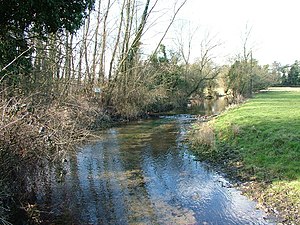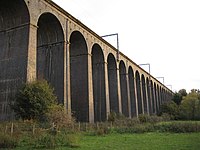River Mimram: Difference between revisions
Created page with 'right|thumb|300px|The Mimram near Poplars Green The '''River Mimram''' is a small river in [[Hertfordshir…' |
m clean up, typos fixed: particualr → particular |
||
| Line 1: | Line 1: | ||
[[File:River Mimram near Poplars Green - geograph.org.uk - 1319730.jpg|right|thumb|300px|The Mimram near Poplars Green]] | [[File:River Mimram near Poplars Green - geograph.org.uk - 1319730.jpg|right|thumb|300px|The Mimram near Poplars Green]] | ||
The '''River Mimram''' is a small river in [[Hertfordshire]] which rises from a spring to the north of [[Whitwell, Hertfordshire|Whitwell]], in northern [[Hertfordshire]]. It enters the [[River Lea]] near Horn's Mill in [[Hertford]]. The river has created the Mimram Valley in the midst of the county, praised for its scenic beauty in | The '''River Mimram''' is a small river in [[Hertfordshire]] which rises from a spring to the north of [[Whitwell, Hertfordshire|Whitwell]], in northern [[Hertfordshire]]. It enters the [[River Lea]] near Horn's Mill in [[Hertford]]. The river has created the Mimram Valley in the midst of the county, praised for its scenic beauty in particular between [[Welwyn Garden City]] and [[Hertford]]. | ||
[[File:Mimram River Near Tewin - geograph.org.uk - 130244.jpg|left|thumb|200x|The Mimram near Tewin]] | [[File:Mimram River Near Tewin - geograph.org.uk - 130244.jpg|left|thumb|200x|The Mimram near Tewin]] | ||
At Whitwell at the top of the river there are cress beds which have existed since Roman times and these are fed by the same springs. The valley extends northwards where it becomes known as [[Lilley Bottom]]. Other sections of the valley are known as [[Kimpton, Hertfordshire|Kimpton]] Bottom and [[Codicote]] Bottom. | At Whitwell at the top of the river there are cress beds which have existed since Roman times and these are fed by the same springs. The valley extends northwards where it becomes known as [[Lilley Bottom]]. Other sections of the valley are known as [[Kimpton, Hertfordshire|Kimpton]] Bottom and [[Codicote]] Bottom. | ||
Although a dry valley to the north, it has been known in particularly wet years for the River Mimram to be extended for several miles by springs in the upper valley. In 2001, in a neighbouring valley to the west a village was flooded<ref>[http://www.kimptonvillage.tsohost.co.uk/flood.htm Kimpton Flood]</ref> | Although a dry valley to the north, it has been known in particularly wet years for the River Mimram to be extended for several miles by springs in the upper valley. In 2001, in a neighbouring valley to the west a village was flooded.<ref>[http://www.kimptonvillage.tsohost.co.uk/flood.htm Kimpton Flood]</ref> The Valley is the furthest east of all the [[Chilterns|Chiltern]] valleys. | ||
[[File:Digswell or Welwyn Viaduct - geograph.org.uk - 1557494.jpg|right|thumb|200px|The Digswell Viaduct]] | [[File:Digswell or Welwyn Viaduct - geograph.org.uk - 1557494.jpg|right|thumb|200px|The Digswell Viaduct]] | ||
Revision as of 12:27, 31 January 2016

The River Mimram is a small river in Hertfordshire which rises from a spring to the north of Whitwell, in northern Hertfordshire. It enters the River Lea near Horn's Mill in Hertford. The river has created the Mimram Valley in the midst of the county, praised for its scenic beauty in particular between Welwyn Garden City and Hertford.

At Whitwell at the top of the river there are cress beds which have existed since Roman times and these are fed by the same springs. The valley extends northwards where it becomes known as Lilley Bottom. Other sections of the valley are known as Kimpton Bottom and Codicote Bottom.
Although a dry valley to the north, it has been known in particularly wet years for the River Mimram to be extended for several miles by springs in the upper valley. In 2001, in a neighbouring valley to the west a village was flooded.[1] The Valley is the furthest east of all the Chiltern valleys.

Between Welwyn and Digswell the Mimran Valley is a broad, green swathe. The railway was driven through here in the middle of the nineteenth century by the Great Northern Railway Company, but the valley proved an obstacle. The solution was spectacular: a 40-arch viaduct, completed in 1850, to carry the railway line to the north from London over the River Mimram. A contemporary newspaper report on the opening of the railway from The Times described it as:
"...consisting of 42 arches each 30 feet wide and 97 feet high and built at a cost between £70,000 and £80,000. The masonry has all the appearance of great solidity..."
The viaduct still served the railway and appears every bit as solid as its descrition over a century and half ago.
The river is the subject (and speaker) of a Stevie Smith poem, The River God.
Outside links
| ("Wikimedia Commons" has material about River Mimram) |
